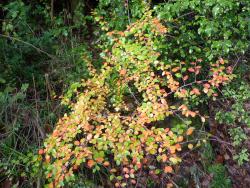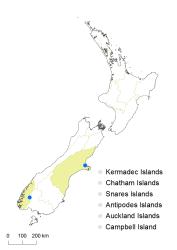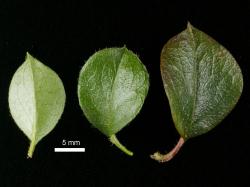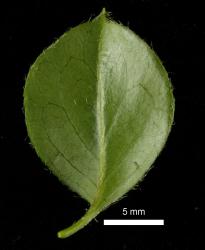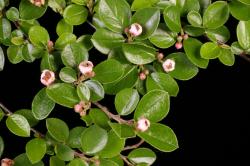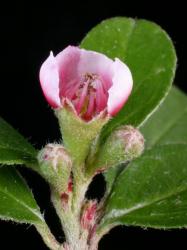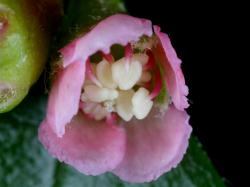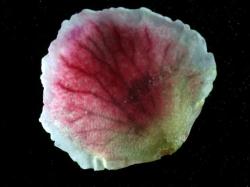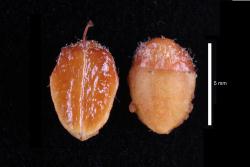Erect shrub,1.0 to 1.5 tall, deciduous. Branches in flattened planes; branchlets purple-brown, peeling cuticle present, branchlet hairs moderately dense, pale yellow; stipule 2.0–4.0 mm long, dark red, stipule hairs sparse or none. Leaves crowded on branches, 16–31.5 mm long, lamina 13–29 mm long, 8.5–17 mm wide, elliptical to obovate, slightly V-shaped, 160–170 µm thick, petiole 2.0–4.0 mm long, petiole hairs moderately dense, pale yellow, leaf base obtuse or cuneate, leaf apex obtuse (smaller, narrower leaves sometimes acute), cuspidate, apiculus straight; lateral veins in 3–5 pairs, midvein impressed in lower half only; upper surface smooth, mid- to dark green, glossy, upper surface hairs sparse or none; margins plane, hairs sparse; lower surface not glaucous, hairs sparse, straight.
Inflorescence of 1–3 flowers, 9–10 mm long, rachis hairs moderately dense; pedicel 0.5 to 2 mm long, hairs moderately dense. Flowers 3.5–6 mm diameter. Hypanthium green with red sepal margins or apices, the hypanthium and sepals turning red after flowering finishes, sepals 1.3 to 1.7 mm long, 1.3 to 2 mm wide, hairs sparse to moderately dense, pale yellow. Petals erect, pink, dark pink at base when open, 4.0–4.5 mm long, 3.1–3.8 mm wide, base clawed, a small tuft of hairs on inside base, margins uneven. Stamens 11–15; filaments 2.5 mm long, pink to dark pink, especially at base; anthers white, 0.7 to 1.0 mm long; styles 2(3), 2.1–2.2 mm long. Fruit vivid red, obovoid, 6.5–7.5 mm long, 6.1–8.9 mm diameter, calyx closed, skin hairs absent. Pyrenes 2(3), 4.9–5.3 mm long, 3.5–4.2 mm wide, hairs moderately dense at apex, umbonate, style attached 1.1–2.0 mm below pyrene apex.
An erect shrub to 1.5 m, deciduous, branchlets in one plane but branching not dense. Leaf lamina 13–29 mm long, 8.5–17 mm wide, orbicular with rounded but apiculate apex, thin-textured, plane, undersurface not glaucous, hairs sparse, straight. Flowers 1–4 per corymb, petals erect, red centrally, pink or white marginally, filaments pink, anthers white, fruit oblong-ellipsoidal to obovoid.
Cotoneaster divaricatus belongs in a group of three very similar species: C. horizontalis, C. perpusillus, and C. divaricatus. All three are low or prostrate shrubs with small to medium-sized leaves that are not glaucous on the undersurface. All three have sparse, straight (strigose) hairs on the leaves, flowers with erect red petals and white anthers. Of the three, C. divaricatus is the tallest, reaching about 1.5 m tall; C. perpusillus is prostrate, and C. horizontalis is intermediate in form, reaching c. 0.6 m, rarely 1.5 m. Cotoneaster divaricatus has acute leaf apices whereas the other two have obtuse apices with a cuspidate tip.
Similar to C. simonsii but that species forms a taller shrub with more erect branches rather than horizontal main branches. Pyrene number overlaps in the two species, but C. simonsii has (2)3(4) pyrenes, while C. divaricatus has only 2(3) per fruit.
Similar to Cotoneaster marquandii in plant size, leaf size, shape and hairs. Cotoneaster marquandii leaves are acute and cuspidate, whereas in C. divaricatus they are obtuse and often cuspidate. The flowers are very similar: petals erect, red centrally, and pink to white marginally, but stamen number is 11–15 in C. divaricatus, not 20 as in C. marquandii. Cotoneaster marquandii has orange fruit that resemble those of C. simonsii and have an open navel, whereas C. divaricatus has red fruit with a closed navel. Cotoneaster divaricatus has 2, occasionally 3 pyrenes, whereas C. marquandii has 3–4 pyrenes.
Canterbury (Port Hills―Victoria Park, 1998–2016), Southland (Lake Manapōuri, 1997)
CHR 513206A–B, W.R. Sykes, 12 Jan. 1997, Lake Manapōuri east side, "Adventive". Given’s (1982) first record of this species is based on a specimen of C. simonsii, CHR 353781.
Flowering: second half of October; Fruiting: January to May, not persisting over winter
Tetraploid (Fryer & Hylmö 2009, p. 178)



